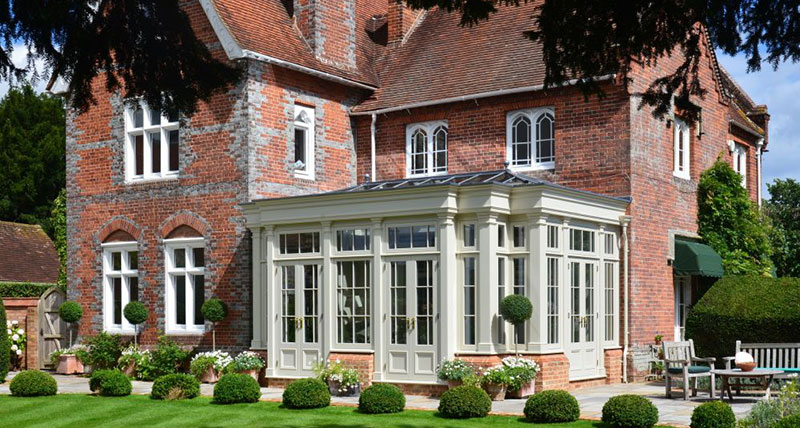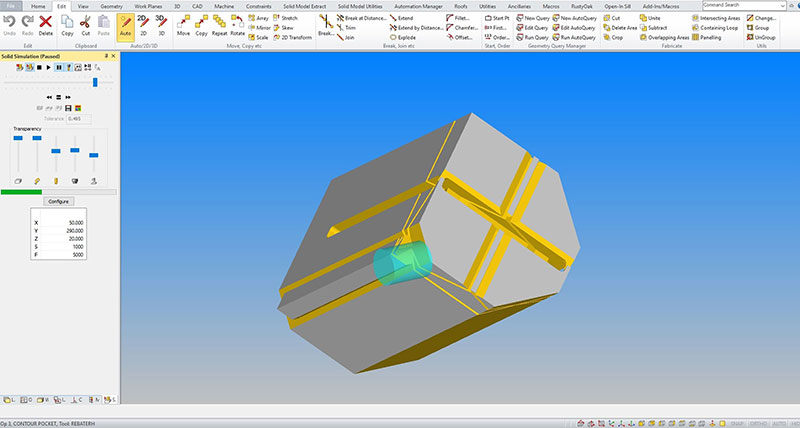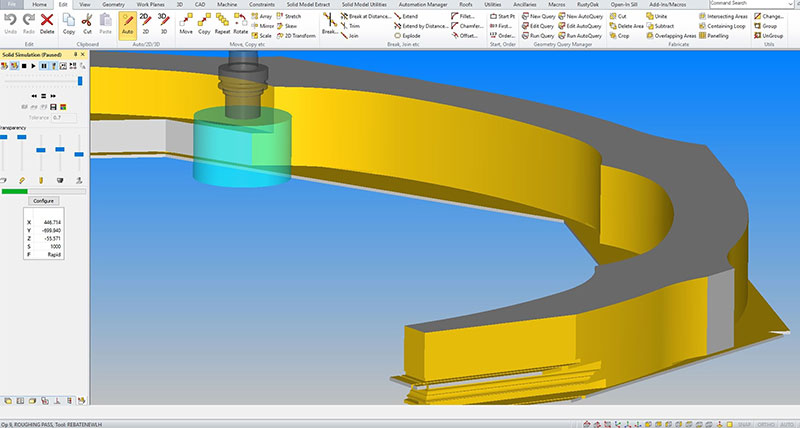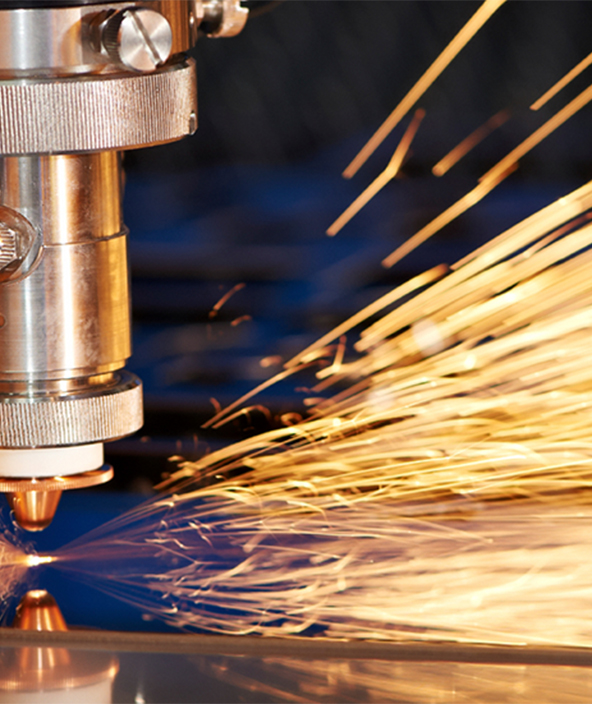Bespoke macros for Alphacam streamline processes for tech savvy David Salisbury
David Salisbury - U.K.
Contact us

The UK’s leading manufacturer of high quality orangeries has developed a unique approach to using Alphacam. It creates specialist macros to populate vital manufacturing information in the software.
David Salisbury Joinery Ltd specialises in the manufacturer and installation of prestigious, contemporary, high quality timber conservatories and orangeries, largely from Sapele hard wood, and Siberian Larch. Operating with around 130 employees from purpose-built premises in Somerset, owner and founder David Salisbury says: “In 2003 we bought our first CNC router to manufacture conservatory roofs and process door leaves. I started creating macros for this.”
The company initially became known for hardwood conservatories; however, its flagship product is now the orangery, which in recent years has become more popular than conservatories due to its flexible usage.
 Processing Manager Graham Hill explains this change in the market: “Conservatories can often be too hot in summer and too cold in winter. Orangeries have flat, insulated roofs with a glazed lantern area in the middle, considerably reducing the glass area. It combines all the good aspects of a conservatory but with a much more liveable room which is an extension of the house. This means they’ve become hugely popular.”
Processing Manager Graham Hill explains this change in the market: “Conservatories can often be too hot in summer and too cold in winter. Orangeries have flat, insulated roofs with a glazed lantern area in the middle, considerably reducing the glass area. It combines all the good aspects of a conservatory but with a much more liveable room which is an extension of the house. This means they’ve become hugely popular.”
Established as the UK market leader in these products, Graham Hill says the company’s technical ability allows them to take on complex and sensitive projects for listed and graded buildings.
“We believe we’re the only company able to take on particular projects – for example when it’s a very complex or sensitive site, we have to work with authorities on what’s acceptable, due to the nature of the building it’s going on to. Our expertise is designing structures that will meet the authority’s approval, while giving the customer what they want.”
Work has recently been completed on Arlington Hall, a National Trust property, which involved replacing the iconic, traditional glass roof Victorian conservatory. The company’s technical approach allowed them to automate much of this project using custom macros in Alphacam.
 “On a typical contract at least half of the components go through Alphacam. In the Victorian days when orangeries were made from stone, the pilasters were stone columns. Now these are replicated in wood using Alphacam. We also put the enhanced facias through Alphacam for the outside cutting on our Maka CNC machine tools. Then the whole of the roof is done through the CNC.”
“On a typical contract at least half of the components go through Alphacam. In the Victorian days when orangeries were made from stone, the pilasters were stone columns. Now these are replicated in wood using Alphacam. We also put the enhanced facias through Alphacam for the outside cutting on our Maka CNC machine tools. Then the whole of the roof is done through the CNC.”
The company has a unique approach to Alphacam, as David Salisbury explains: “I’d always had a keen interest in the different geometry of conservatory roofs. I wanted a software solution that would allow us to solve any geometry issue.”
Alphacam is used in two ways; first, traditionally for complex bespoke parts and curved work which is generally unique; and second, with macros to automate large repetitive jobs. Graham Hill says: “We use macros that we write ourselves for around 75 per cent of the work we do, which import the relevant information into Alphacam. The macros effectively provide a platform for telling Alphacam what to do by populating all the relevant fields.”
Working to tolerances of 1mm of less, high accuracy is vital to ensure the completed product is correct. “We’ve honed our processes over many years, to the extent that we don’t assemble any of our roof structures in the factory…each component is taken to the customer’s site and erected there, without ever having been put together before, because we’re completely confident of the accuracy that when it goes up on site it will all fit perfectly.”
The Alphacam macros play such a key role in the running of the business that they employ a full time Software Developer, Adrian Fear, who supports existing macros with improvements, and creates new ones. “The macros allow us to automate production without having to do manual CNC work. We drive most of it from a database, pushing through all manner of information, including length, breadth, width, tenon information, pocket information that the tenons go into, rebates, mitres…it’s all the information needed to cut the component.
 “Without the macro we’d have to input that information into Alphacam either manually or drop in an existing drawing and adjust it.” Adrian Fear is currently developing new software for their Oak Building range and, once finished, the macro-based solution should reduce CNC programming time down from four days, to about three hours.
“Without the macro we’d have to input that information into Alphacam either manually or drop in an existing drawing and adjust it.” Adrian Fear is currently developing new software for their Oak Building range and, once finished, the macro-based solution should reduce CNC programming time down from four days, to about three hours.
Alphacam’s ability to take the macros in its stride to create the NC code is a huge benefit. For a design that has already been proven out, it takes only 30 seconds to pull in the component, run a standard simulation test, and then post straight to the machine.
CAD/CAM Programmer James Davis uses Alphacam and macros on a daily basis. He says the macro screen requests the data which opens a drop-down list of components. “All components have different features, but the individual macro can populate all the fields for most of the components we need. So simply picking the component from the drop-down menu generally populates all the required fields. Once the code’s created and posted, that’s the macro’s job finished for that component.”
Alphacam 3D simulator is used to check before posting to the CNC machine. The two machines used, Maka 1 and 2, have 32 tools on each and are capable of full 5-axis routing, with Maka 1 working with bigger pieces of timber. Maka 2 has twin channels with automated pods in line for robot loading. The machine sets them up wherever they’re programmed to be, and the robot loads the timber on. David Salisbury says robotic loading presented the most difficult programming challenge, to position the vacuum pods automatically. “We worked closely with Alphacam’s application engineers on developing this. Now we’ve got a fully automated system where a bar code ties in with the NC code generated by Alphacam. It goes onto the machine, which reads the bar code and calls up the right NC code. That’s been very successful.”
